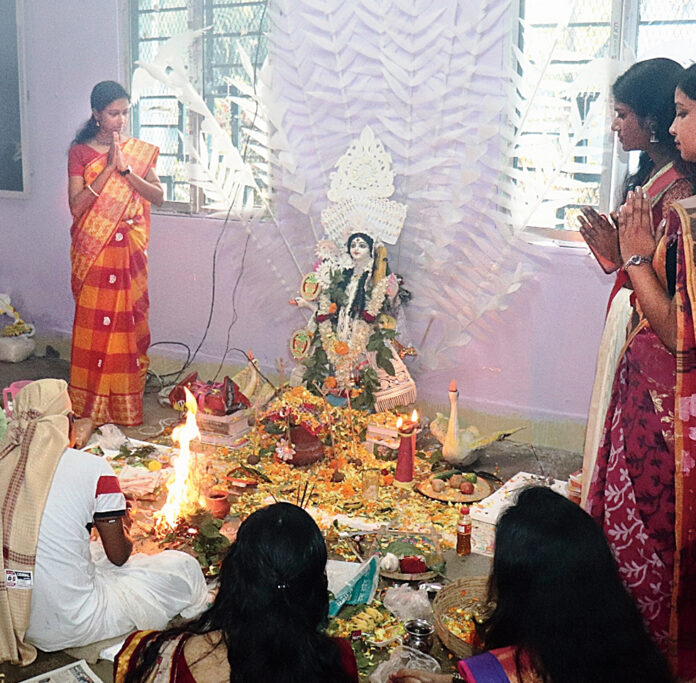Saraswati Puja, harbingering the arrival of spring, is widely known as ‘Vasant Panchami’ in the other parts of India. In Bengal, it is an occasion for the students; all the educational institutions, besides the households, celebrate this day. Saraswati Puja in Bengal in unique in so many ways. The image of Saraswati has two hands as opposed to four hands in the rest of India and she is accompanied by a swan rather than a peacock. There are numerous traditions associated with the Saraswati Puja which is unique to Bengal. In this article, we list down ten such traditions which every Bengali is proud of.
- Neem and turmeric: The ritual of Saraswati Puja begins early in the morning. The students take an early bath by smearing themselves with neem and turmeric paste, a tradition being carried on for ages. In the earlier days, tulsi and neem leaves were immersed in the water pot before bath. Neem and tulsi have antibacterial and antifungal elements helps in prevention from pox (known as Basanta in Bengali, literally meaning ‘the spring disease’) which generally affects us this time of the year. Therefore, these practices seem to have scientific reasons behind them.
- Palash: The devotees offer anjali by showering flowers, especially the seasonal palash or flame of the forest (Butea monosperma), which is a mandatory element of Saraswati Puja, at the feet of the clay idol of the deity. In the Puranas, goddess Saraswati is mentioned as the goddess of fertility and productivity. Women become fertile after menstruation and the colour of menstrual blood is red, which the colour of palash as well. Hence, ‘Palash’ is used as a symbol of fertility.
- Khager Kalam and Doat: The naivedya of the puja includes an earthen pot called doat (ink pot) filled with milk which symbolizes ink and khager kalam (pen made of reed). Before the advent of fountain pen, Bengalis used to write using khager kalam. The khager kalam is used to write the pranam mantra (hymn of worship) with the milk, on bel (wood apple) leaves. Khager kalam and doat are included in the naivedya as a study material. Students also keep their books, pens and musical instruments beside the idol for the whole day to receive blessings of the goddess and happily stay away from the books on this day.
- Kul: The seasonal fruit kul or Indian jujube (Ziziphus mauritiana) has special significance in the context of Saraswati Puja. Bengalis refrain from consuming the fruit before offering it to the goddess. A kul is carefully balanced on top of the doat and forms a part of the naivedya. Students believe that if they consume kul before Saraswati Puja, they would fail in the exams. After the anjali, the fruit is consumed as prasad. It is also customary to have chutney made of ripe kul (also called topakul) on this day.
- Haatekhori: This auspicious day also marks the Haatekhori (chalk in hand) for Bengali toddlers who enter the premises of knowledge by writing their first alphabets, administered by the priest, on slate boards with chalks in front of Saraswati. The alphabets begin with Anji (Unicode U+0980), followed by the vowels and consonants. Anji also known as Siddhirastu means ‘may there be successes.’ According to Tantra, Anji symbolizes the invocation of Adya Shakti Mahamaya.
- Yellow dress: Yellow signifies spring, life and well-being. Yellow is also said to be the favourite colour of Saraswati. Bengalis prefer to wear yellow on this day. Women were yellow sarees and men were yellow panjabis and spent the day in day in festivities. Women also sometimes wear floral ornaments made of yellow genda phool or marigold.
- Love is in the air: In Bengal, this day has another significance as it’s the day when love is in the air. The Saraswati Puja day is now popularly known as the Bengali Valentine’s Day. In the afternoon one will hardly fail to notice the crowd of couples clad in traditional clothes — women decked up in saris and men wearing panjabis. The tradition is believed to have originated from the practice of boys’ school students visiting the girls’ schools and vice versa as part of Saraswati Puja invitation which provided an opportunity for interaction between each other.
- Khichuri and Basanti Polao: Bengalis traditionally prepare either Khichuri or Basanti Polao on this day. Both the dishes are made of Gobindobhog rice. While Khichuri is a pan-Indian dish and a meal in itself, Basanti Polao (literally ‘spring pilaf’) is a quintessentially Bengali dish which is usually accompanied by another Bengali delicacy called Alur Dom. The Basanti Polao is bright yellow in colour, signifying spring and tastes sweet, often sprinkled with cashew nuts and raisins.
- Gota Sheddho: On the next day of Saraswati Puja i.e. on the day of Visarjan (immersion of the deity), the Bengalis of western Bengal known as the Ghotis celebrate Shital Shasthi (literally ‘The Cold Sixth’). It is prohibited to light a fire for preparing food. On this day they have panta (cooked and fermented rice), and gota sheddho (literally ‘whole boiled’) or boiled whole vegetables, cooked on the previous night. The Ghotis generally refrain from cooking and consuming warm food on this day.
- Jora Ilish: Saraswati Puja marks the commencement of the Hilsa consumption season for the Bengalis of eastern Bengal, known as the Bangals. Hilsa, arguably the most popular fish among the Bengalis, is prohibited from consumption between the Kojagari Lakshmi Puja and Saraswati Puja to allow breeding. The male member of the family brings home jora ilish (literally, ‘a pair of Hilsa fish’) and the women of the family welcome the fish with coins, turmeric paste, mustard oil, vermilion etc. The pair of fish is offered as naivedya to the goddess and consumed as prasad.
Saraswati Puja in Bengal is not celebrated as a mere puja, it is an emotion. The students wait for a whole long year for this day as it is a special day for them and their energy, excitement, and zeal transform this auspicious day into a special one indeed.
Picture credit: Telegraph India ( https://www.telegraphindia.com/west-bengal/saraswati-puja-message-against-forces-of-division/cid/1740723 )




































